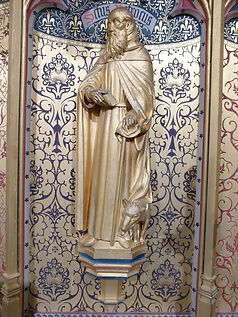St Petroc...

The legend of St Petroc is unfortunately lost, but we can piece together his life with tolerable accuracy from the account of John of Tynemouth (circa 1366), who had access to earlier histories supplemented by Welsh and other chronicles.
Somewhere in the middle of the sixth century after Christ, a boat of wickerwork covered with hide (a sea-going coracle), in fact sailed into the estuary of the Camel. It came from Ireland, then the land of civilization and religion and carried Petroc and his three companions Croidan, Medan and Dagan. Petroc was a Welsh or Cornish prince who in his boyhood had gone to Ireland and embraced the monastic life.
He landed just above the town of Petrockstow or Padstow, then called Laffenac or Lodenic. Here he found some harvesters from whom he begged some water, the supply of which had probably run out during the voyage. They treated him with incivility and bade him find a spring for himself; this he did by driving his staff into the ground. The inhabitants of this part of Cornwall were at the time only partly converted to Christianity, but St Samson was already at Padstow, his cell being in what is now the garden of Prideaux Place; on Petroc’s arrival Samson yielded the field to his brother in the Faith and departed on his travels. Petroc remained in the neighbourhood of Padstow for about thirty years, preaching the gospel and gathering round him a band of monks. Like all the British saints, he practised the most rigid asceticism, and there is no doubt that the austerity of those early missionaries made the deepest impression on the emotional Celtic tribes.
One of the most remarkable practices was that of praying in the water of wells and rivers and St Petroc is said to have spent much of his time sitting up to his neck in the Little Petherick river reciting the psalter. His food was bread and water, with porridge on Sundays.


The Celtic saints were restless men, constantly travelling. St Petroc had a pet wolf which guarded his sheep-skin mantle. Power over wild creatures is an attribute of personal holiness in all countries and ages down to our own time and was largely possessed by the Celtic Saints if their histories are to be believed.
Petroc died on June 4, it is believed at Treravel, while travelling between Little Petherick and Padstow, and this day is still kept as his Feast Day in this parish either on the day itself or some other convenient day about that time.
You will find the St Petroc’s hymn hanging on the pillar in the centre of church, this hymn is still sung today on the feast day of St Petroc. You will also find statues and figurines of St Petroc by the candle stand, behind the altar rail and on both reredos, along with a splendid banner on a staff standing in the Lady Chapel that has been used in past processions.
Taken from the 1912 publication of the history booklet made for the church.